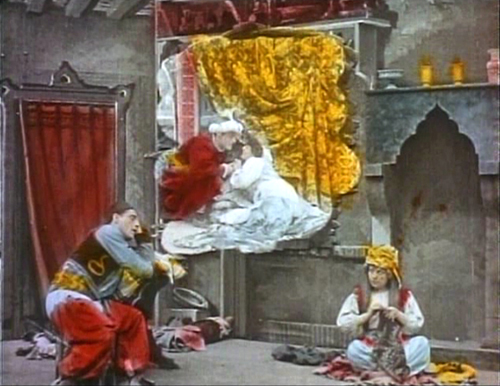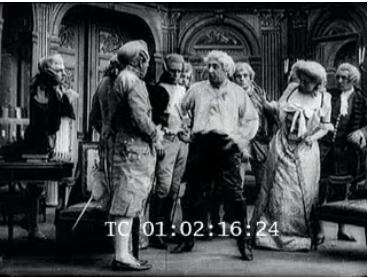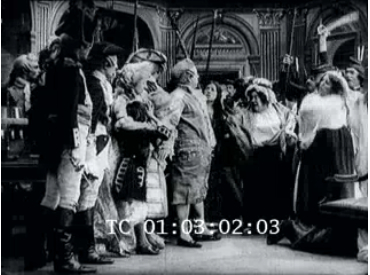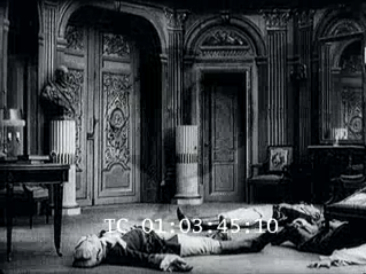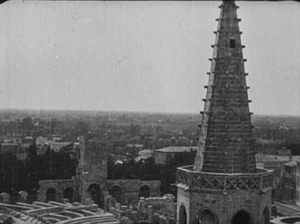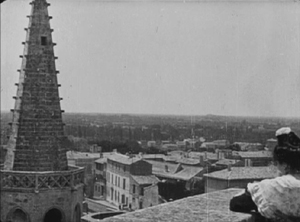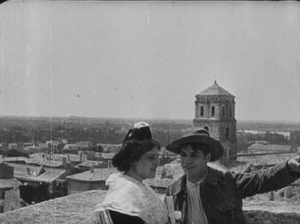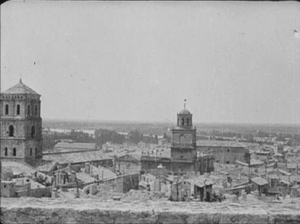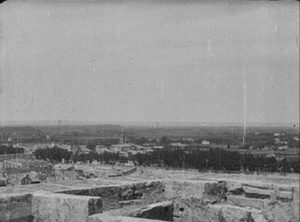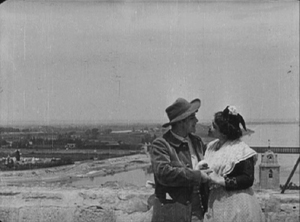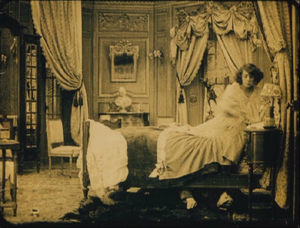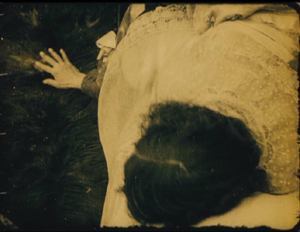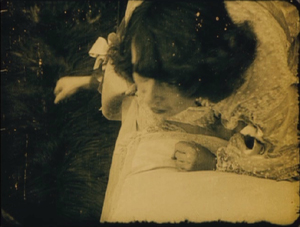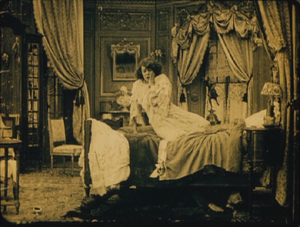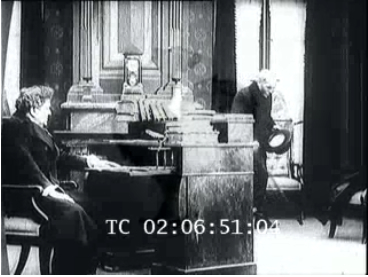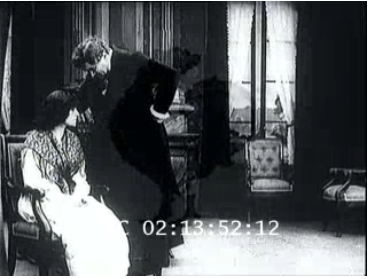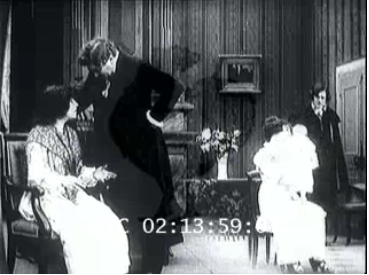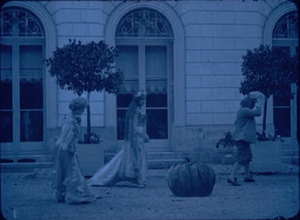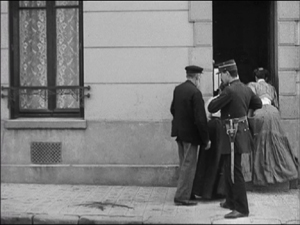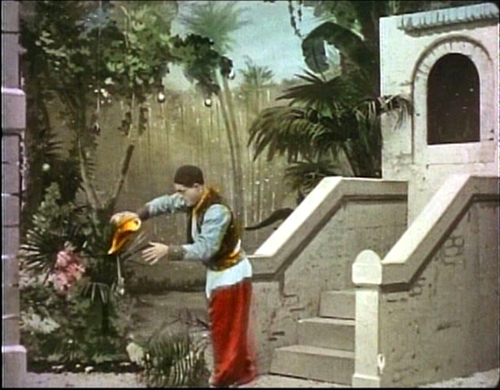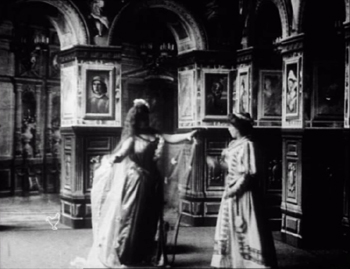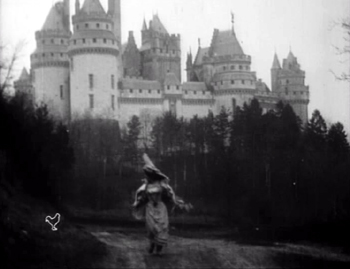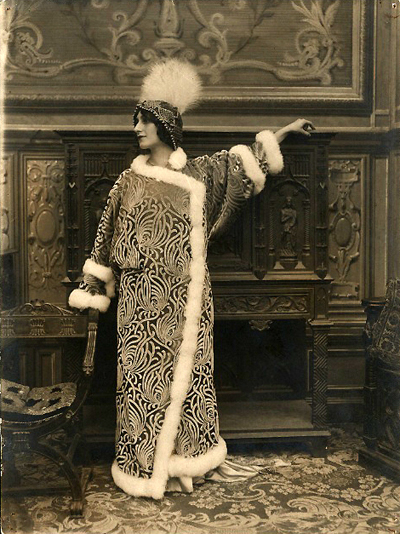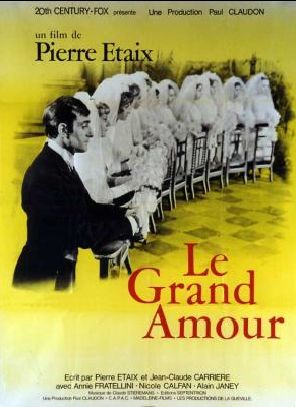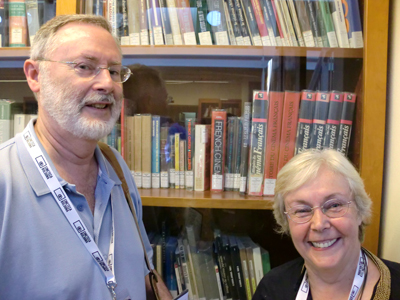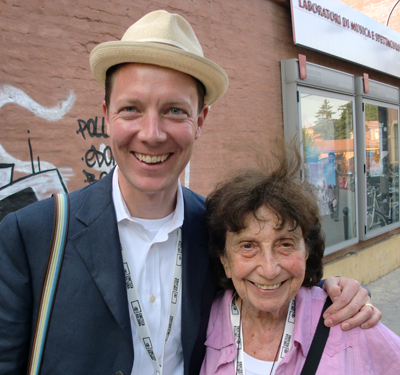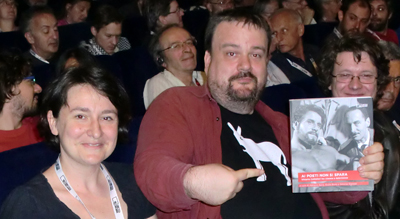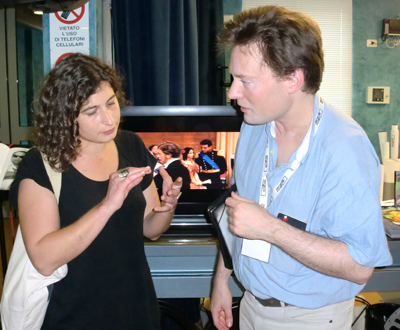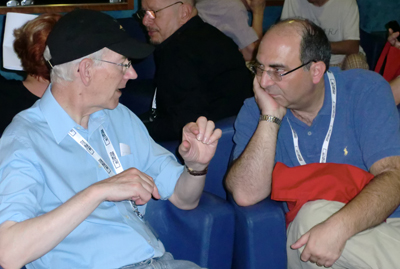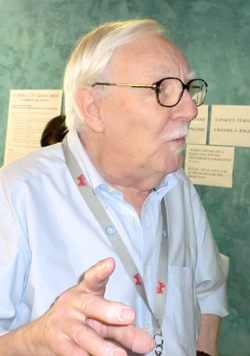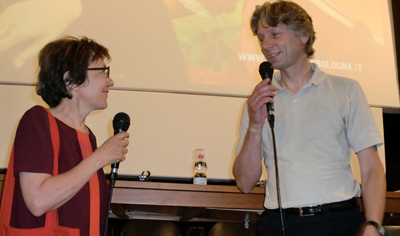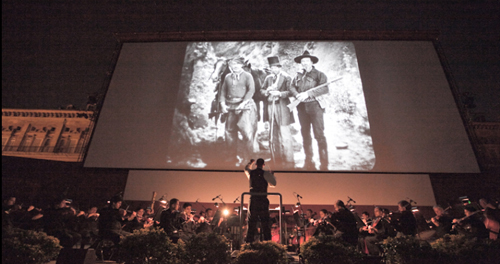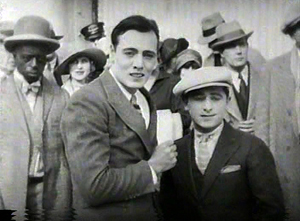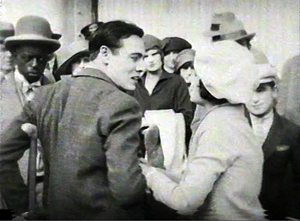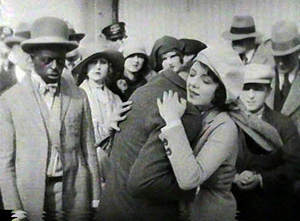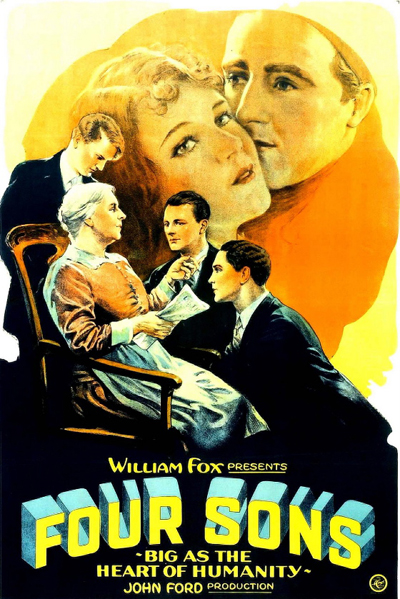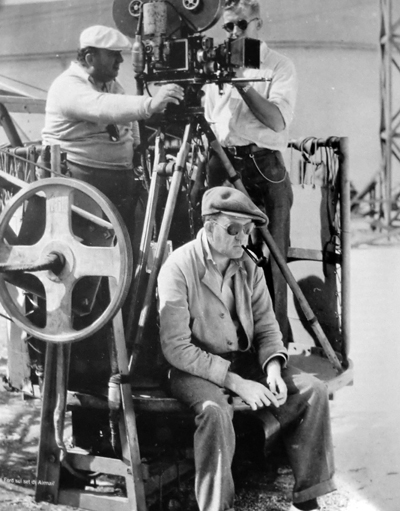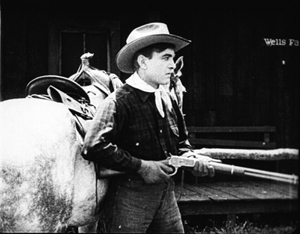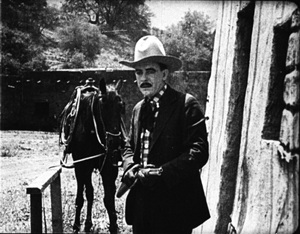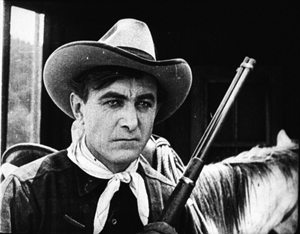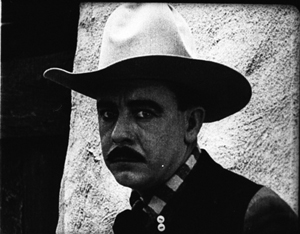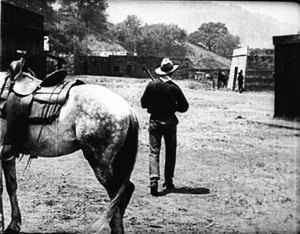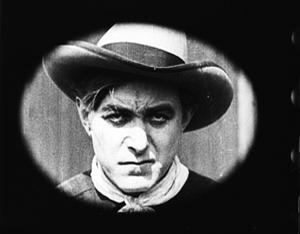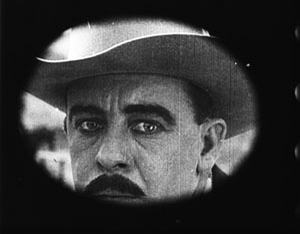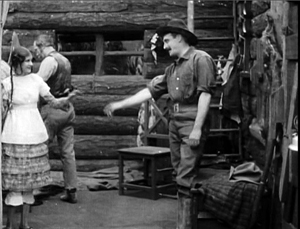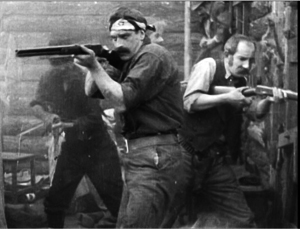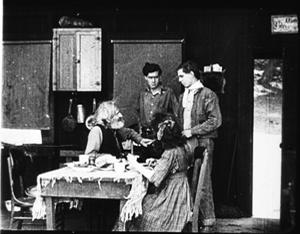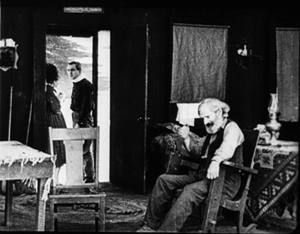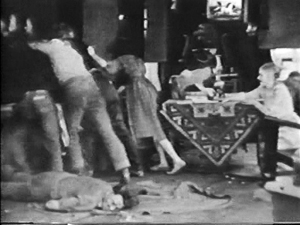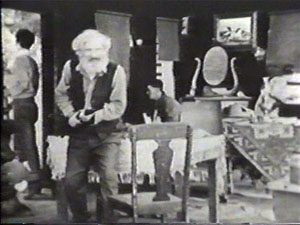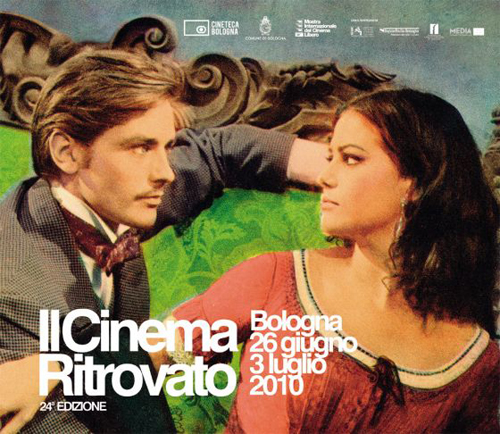Archive for the 'Film technique' Category
Capellani ritrovato
Aladin ou la lampe merveilleuse.
Kristin here–
[Note, July 11, 2011. The release of a considerable number of Capellani films on DVD since the 2010 festival has allowed me to add some frames to my examples below. The frames from L’Arlésienne, L’Épouvante, and Pauvre mère are new, and the one from Cendrillon has been replaced by a better copy. For more on the DVD, see the entry on the second half of the retrospective.]
Back in the 1980s and early 1990s, researchers into silent cinema became used to the discovery of little-known auteurs. The 1910s proved an exceptionally rich source of directors beyond the familiar names of Griffith, Ince, Chaplin, Feuillade, Lubitsch, Stiller, and Sjöström.
In 1986 Le Giornate del Cinema Muto’s epic retrospective of pre-1919 Scandinavian cinema revealed the Swedish master Georg af Klercker. In 1989, a similarly ambitious presentation of pre-Revolutionary Russian films brought the work of Evgeni Bauer to light. In 1990, the “Before Caligari” year added Franz Hofer to the list of obscure directors at last receiving their due. After that quick series of revelations, there has been a dearth of such significant revelations until, some would argue, now.
This year Bologna’s Il Cinema Ritrovato presented 24 films directed by Albert Capellani (1874-1931), previously known mainly to specialists for two films, his magisterial adaptations of Hugo in the four-part serial Les Misérables (1912) and of Zola in Germinal (1913). The retrospective has been 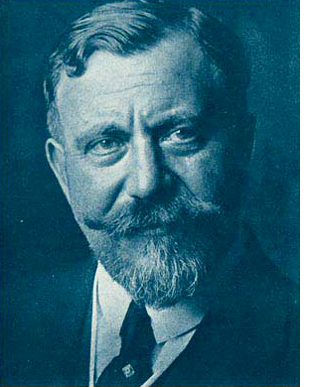 arranged by Mariann Lewinsky, who, as in previous years, has also been responsible for this year’s “Cento anni fa” program, covering the output of 1910. (The “Cento anni fa” series began in 2003, with Tom Gunning as programmer, and Mariann took over that duty in 2004.)
arranged by Mariann Lewinsky, who, as in previous years, has also been responsible for this year’s “Cento anni fa” program, covering the output of 1910. (The “Cento anni fa” series began in 2003, with Tom Gunning as programmer, and Mariann took over that duty in 2004.)
A gradual rediscovery
When Georges Sadoul wrote his multi-volume Histoire général du cinéma, the second part (1948) mentioned Capellani a few times. With the lack of available prints of the films, however, he was limited to treating the director primarily as the head of S.C.A.G.L., the prestige production unit launched by Pathé in 1908. Richard Abel’s The Ciné Goes to Town: French Cinema 1896-1914 (1994) devotes considerably more space to Capellani. Dick was able to view and analyze seven of the shorts and four features but was hampered by the incompleteness of some of these and the lack of such key films as L’Arlésienne (1908). As Mariann points out in her program notes, Capellani’s significance has been commented on by several scholars, including our colleagues Ben Brewster and Lea Jacobs. (Ben’s detailed analysis of the acting in Germinal is here, including a citation to a 1993 article on the film by Michel Marie).
Mariann, however, has recently been instrumental in bringing Capellani’s films to broader attention. The decision to mount retrospectives of his work has spurred archives to restore several which had been unavailable or lost, and more prints will presumably be ready for next year.
Capellani has actually been creeping up on us in Bologna for some time now. In 2006, Mariann’s programs from 100 years ago had reached 1906–the year when Capellani’s career really got started, though at least one of his films appeared in 1905. We saw only one from 1906, La Fille du sonneur. I can’t say that I remember anything about it. In the 1907 program, Les Deux soeurs, Le Pied de mouton, and Amour d’esclave. Again, I probably would have to say that I don’t recall these films, except that I vaguely recognized Le Pied de mouton, a fairy tale about a young man who receives a magic object in the form of a large sheep’s foot, when it was shown again this year.
By 2008, however, a pattern had started to emerge, and Mariann showed seven Capellani films, with six of them forming one program devoted solely to the director’s work, “Albert Capellani and the Politics of Quality”: La Vestale, Mortelle idylle, Corso tragique, Samson, L’Homme aux gants blancs, and Marie Stuart. The seventh, Don Juan, appeared in the “Men of 1908” program.In visiting archives and choosing films Mariann often saw prints without credits and from unknown directors, so the pattern only gradually became clear. In the 2008 catalogue she reflected on her realization that Capellani was showing up regularly in her choices for the annual centennial celebrations: “When organising the 1907 programme, however, in the light of Amour d’esclave, a gorgeous mise-en-scène of classical antiquity, I asked myself for the first time, ‘Who made this sophisticated film?'”
She speculated that the relative neglect of Capellani perhaps came from the Surrealists’ campaign against highbrow filmmaking during the 1910s and 1920s:
From his very first film on–the memorable Le chemineau of 1905, based on an episode from Victor Hugo’s Les Misérables–Albert Capellani transports the contents and qualities of bourgeois culture to the cinema. He films Zola, Hugo and Daudet–his Arlésienne of 1908 has unfortunately been lost. His many fairy tale films (scène des contes), biblical and historical scenes reveal him as a great art director, who also adopted the latest developments in modern dance and worked with its stars Stacia Napierkowska and Mistinguiette. Highly versatile, he had an unerring sense of the best approach to a given genre.
Fortunately, L’Arlésienne has subsequently been discovered by Lobster Films, just in time to be presented this year.
The 2009 program contained only two Capellani films, but one was the extraordinary Zola adaptation L’Assommoir. This had been known only from fragments until a complete copy was found in Belgium. It displays an unusual degree of realism that fits the naturalist subject matter and also contains complex and deft staging that moves numerous characters around a scene in a way that shifts the spectator’s attention among them exactly as the flow of the narrative requires. The other, La Mort du Duc d’Enghien, was shown again this year. It’s a rare case of an historical drama of the period that manages to arouse a genuine sympathy for its main character, a young nobleman unjustly arrested and executed upon Napoleon Bonaparte’s orders. More on it later. The 2009 catalogue announced that in the following year, Capellani would graduate from the annual “Cento anni fa” programs to his own retrospective.
This year’s films
This first full-fledged Capellani retrospective gave a generous though not complete overview of his surviving films from early 1906 to 1914—a few bearing 2010 restoration dates. Capellani also worked in the United States from 1915 to 1922, and the program included The Red Lantern, a 1919 feature starring Nazimova. This, Mariann’s notes assure us, is “a taster for next year’s festival,” which will include further restorations from the French period, as well as more features from his American career. (It would be good to see the other Capellani films shown in previous years repeated, now that we have a sense of his work more generally.)
Ideally our examples here should include frames from the films shown at this year’s festival, but none of them is out on DVD. The Brewster article linked above has a generous selection of well-reproduced frames from a 35mm print of Germinal. As far as I know, the only Capellani film available on DVD is Aladin ou la lampe merveilleuse, on the third volume of Kino International’s “The Movies Begin” set. I’m sure it was included there not because it was a Capellani but because it survives in beautiful condition and is an epic with elaborate hand-coloring. I’ve included frames at the top and bottom of this entry, despite the fact that it has not been shown at Bologna. The smaller frames illustrating a few of films shown at Il Cinema Ritrovato come from the Gaumont Pathé Archives website (registration required). This site is the best online source of information on the director’s films, including complete video versions in a few cases. These are, however, quite small screens, and they display the double branding of a prominent timer and a bug of a Pathé rooster superimposed over much of the frame.
Capellani had worked in the theater as a director and actor until Pathé recruited him in 1905. In a sense, he became a specialist in literary adaptations, especially after his appointment in 1908 as artistic director of S.C.A.G.L. Yet the films being shown this year include pure melodrama (such as Pauvre mère, “Poor mother,” 1906), crime-suspense films (L’Épouvante, “The Terror,” 1911), classic fairy-tales (Cendrillon, 1907), and historical/biblical costume pictures (Samson, 1908).
With his theatrical background, it is not surprising that Capellani was able to cast many old colleagues in his films, notably Henry Krauss, who played Quasimodo in Notre-Dame de Paris (1911) and Jean Valjean in Les Misérables (1912). Wherever his actors came from, however, Capellani was a master at directing performances. In many cases the acting makes characters who would seem completely conventional figures in most films of the day into people with whom the audience can empathize.
The staging in Capellani’s shots is inevitably impeccable. The progression of the story is clear even in shots with numerous characters on camera. More of his stage experience coming out, one might say, but he also adapts his technique to the visual pyramid of space tapering toward the camera’s lens.
L’Évadé des Tuileries (1910), for example, deals with the Count du Champcenetz, the governor of the Tuileries during the French Revolution, who initially tries to alert the royal family to their impending arrest and subsequently flees for his life from the revolutionary forces that invade the palace. In the most spectacular shot, he rushes in, exhausted and wounded, to speak to the king as the members of the royal family gradually enter and guards surround them. Champcenetz collapses and slides partway under a chair at the foreground right as the revolutionaries burst into the room. The business of the ensuing struggle, the departure of the combatants with the royals under arrest, and a short burst of looting leaves a still scene with the dead and wounded on the floor. Suddenly an arm moves at the far lower right corner of the frame, and we become aware that Champcenetz has survived.
David has praised the sustained tableau staging in depth of the 1910s, in the films of Feuillade, Sjöström, Hofer, and others, but here is Capellani doing it all in 1910—and this is not the first of his films to display such control of the complex arrangement of actors in space.
None of this is to suggest that Capellani’s films are “stagey.” He is quite capable of a cinematic flourish for purposes of dramatic effectiveness. L’Arlésienne, shot largely on location in the old town of Arles, includes a shot of the young couple atop a tower that looks over the cityscape. The camera begins on the spire, panning right until the couple appear in medium shot, with the town beyond them and the parapet. They wander out right, and the camera pans around the parapet, only catching up with the couple when they are roughly 180 degrees opposite to where the camera started:
It is hard to believe that in London L’Arlésienne played on the same program as L’assassinat du Duc de Guise, which, sophisticated as it is in some ways, seems seems downright old-fashioned when contrasted with Capellani’s film.
Even flashier is L’Épouvante, which seems at first a simple story of a young woman in danger as she retires for the night, unaware that a burglar had stolen her jewelry just before she came in and is now hiding under the bed. She lights a cigarette and carelessly tosses the match on the floor. The camera tracks slowly back from the bed to bring the burglar into view; he registers fear that the match is still alight and might set the rug on fire. He reaches to snuff it out, and a sudden cut places us at a high angle above the heroine as she looks down and sees the hand appearing from beneath her bed. A return to the long shot displays her reaction:
Up to this point our sympathy has been entirely with the heroine. But once she escapes the room and locks the burglar in, his struggle to escape before the police find him takes up much of the remaining action and gradually gains him our sympathy as well. Trapped multiple stories up, he climbs to the roof, only to have to retreat as the pursuers rush up and search there. Moving downward, the burglar ends up hanging by an ominously bending gutter.
Only the heroine is left in her flat to discover his plight, and she lowers some drapes for him to climb up. In a touchingly awkward scene, the man is relieved but unable to express his gratitude except by returning the stolen jewelry and silently exiting, while she makes no attempt to stop him. In a way, L’Épouvante reminded us of Suspense, Lois Weber and Phillips Smalley’s remarkable 1913 film of a woman besieged in her house by a burglar, but the unexpected shift of emotional dynamics between the two characters in Capelanni’s film makes it equally memorable.
Capellani’s pictorial sense in real locations has been widely remarked upon. Even in La Mariée du château maudit (1910), a relatively slight tale of spooky doings in a deserted castle where a wedding party plays hide-and-seek, becomes impressive in part because of its use of an extensive set of actual ruins. There’s also a remarkable moment after the bride accidentally becomes locked in a room with a skeleton dressed in a bridal gown. She reads an old book telling of the young woman’s fate, and two successive bits of the story appear as matte shots on the right and left leaves of the open book. (Working at Pathé, Capellani could use impressive special effects, as the dream image in the Aladin frame at the top demonstrates.)
The sets are masterful as well. I was particularly struck by Jean Valjean’s desk in the second episode of Les Misérables (1912). It creates an effect of forced perspective that is like German Expressionist eight years ahead of its time. Valjean has escaped from prison and become a mayor and successful small-factory owner. Javert, formerly a guard at the prison and now a local police officer, suspects Valjean of being the fugitive. Now he comes to Valjean’s office to introduce himself.
Valjean sits at the left behind an enormous desk which dominates the left and center of the screen; its size is exaggerated by rows and stacks of thick volumes ranged across its top. About a third of the screen is empty at the right, where Javert enters at the rear and walks only partway forward. The effect is to make Javert appear smaller than he really is, with the low camera height that Pathé films were using by this point exaggerating the effect; during part of the scene he is also partially blocked by the desk. The suggestion is that he has no ability to follow up his suspicions of such a powerful man.
In a subsequent scene, when Valjean brings the ailing worker Fantine to his office, the desk has been moved away from the camera, which frames the scene from further to the right. The result is a far more open space at the right, while Valjean brings forward a chair for Fantine that puts her in front of the desk. Unlike Javert, she is not dwarfed by the desk, which, once Valjean comes to lean over her, is barely visible. Instead, the right half of the screen is left unoccupied so that a flashback can fill it.
In the scene like the one with Javert, a German Expressionist film would have exaggerated the size of the desk even further and perhaps tilted the floor up at the rear, but the effect is clear and dramatic enough as it is. Again, it is not an effect one would expect to find in a film of the early 1910s. There is also a contrast between the massive desk and the relatively small, insubstantial table that Javert uses as a desk in the setting of the police headquarters
Even the most conventional films receive what I began to recognize as Capellani touches, often to bring a moment of realism into a fantasy or melodramatic setting. In Cendrillon, the gardener who carries in a huge pumpkin to be turned into the heroine’s magic coach exits wiping the sweat from his head with a handkerchief (below left). The little girl who falls out of a window to her death in Pauvre mère leaves a large, dramatic splotch of blood on the sidewalk when her lifeless body is lifted—a realistically gory touch of a sort which I don’t recall seeing in any other film of this era (below right). When the hero finds the magic lamp in Aladin ou la lampe merveilleuse, he blows dust off it and turns it over to shake out further dirt (see bottom).
Another sort of touch appears in La Mort du Duc D’Enghien, a carefully executed motif of a sort one doesn’t often see in films of this type. The hero is arrested while at a hunting lodge, and throughout he wears a distinctive hat that’s probably part of a hunting outfit. He throws it defiantly to the floor during the courtroom scene in which he is unjustly condemned; he throws it down again in his cell, this time to indicate despair and exhaustion; in the final execution scene, he tosses it aside as part of his brave resignation, facing the firing squad with open arms and without a blindfold. These moments aren’t stressed, and one could understand the plot perfectly well without noticing the repetition. Still, the motif helps characterize D’Enghien quickly in this relatively short film and indicates the care with which Capellani was crafting even his one-reelers.
Mariann was somewhat apologetic about La Glu, a 1913 feature, since it centers around a femme fatale who victimizes three men in the course of the narrative. The title is the heroine’s nickname, and it means what it sounds like, “glue,” and particularly sticky substances like bird-lime that are used to ensnare. But the audience thoroughly enjoyed this distinctly absurd but entertaining and fast-paced tale of a heartless, mercenary woman, played with relish by Mistinguett, and the men foolish enough to fall for her. After all, there are plenty of depictions of love-’em-and-leave-’em men from this period, so why not turn the tables? At least one flagrant coincidence brings all of them to the south of France, where the heroine goes for a vacation, and Capellani contrasts the early scenes of high-society Paris with the stark seascapes in and around a fishing village. Though another literary adaptation (from a novel and play by Jean Richepin), this film certainly stands out among the pre-war features and demonstrates once more Capellani’s versatile ability with a range of genres.
After all these treats, the last French feature on offer, Le Chevalier de Maison-Rouge (1914), proved a slight let-down. Capellani had a penchant for substituting letters and other texts for intertitles, but this film pushes the device to the point where sometimes it seemed as if every other shot was an insert. The plot, dealing with a scheme to rescue the imprisoned Marie Antoinette, was also frustratingly complicated and not presented with the admirable clarity that characterizes most of the other films. As I’ve mentioned, Capellani was often able to generate an empathy with the characters which is rare for films of this period, but as a result of the constant plot twists, the Chevalier and his endangered mistress remain rather remote figures. There are some effective moments, though. One exterior view of the protagonist’s home places a door at the upper center, approached by a symmetrical pair of staircases running to the right and left and forming a pyramid shape. A foreground pond elaborates the space still further, so that when a crowd tries to break in, the staging utilizes the frame vertically and horizontally, with intricate movements of individuals to avoid the water.
Ahead of his time–up to a point
As I remarked in an entry on last year’s festival, L’assommoir struck me as looking like it had been made in 1912 or 1913 rather than 1909. Now it becomes clear that many of Capellani’s films give this sense of trying things that other filmmakers would begin doing routinely a few years later. In some cases, like L’Arlésienne, it’s a focus on acting of a sort that we associate with Griffith’s films like The Mothering Heart or The Painted Lady. In others, it’s the motifs or the subtle changes of framing or the eye for landscapes. Although the editing is not usually flashy, Capellani is good at keeping spatial relationships clear, as the series of shots depicting Valjean’s escape from prison in the first part of Les misérables demonstrates. As Mariann wrote, he seemed able to adapt to any genre. I’m not a particular fan of the historical films so common during this period, but Capellani manages to humanize most of his.
It was only with Le Chevalier de Maison-Rouge that the sense of Capellani being ahead of most of the directors of his time largely disappeared, though it seems premature to judge from a single 1914 film. Perhaps during the immediate pre-war era, and especially the creatively fecund year of 1913, the exploration of the cinema by an increasing number of masters created a spurt that he did not participate in. And perhaps more films from 1913 and 1914 will appear in next year’s retrospective and give us a better sense of how his career developed in that crucial period. It will also be interesting to trace his assimilation of the developing classical Hollywood norms once he moved to the U.S. By 1919 and The Red Lantern, he clearly had absorbed the norms thoroughly, and his style had become indistinguishable from that of his American colleagues.
Added July 13: Roland-François Lack has kindly written to point out that another Capellani film exists on DVD. (Thanks, Roland-François!) His 1908 version of the French tale Peau d’âne was included as a supplement on the 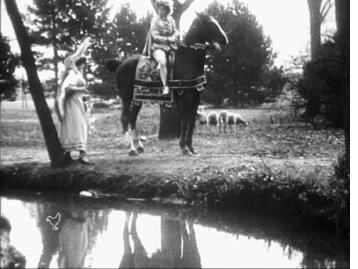 collector’s edition of Jacques Demy’s film of the same name. It is also included in the “Intégrale Jacques Demy” 12-disc set. These DVDs are Region 2 (Europe) and won’t work on other region-coded players.
collector’s edition of Jacques Demy’s film of the same name. It is also included in the “Intégrale Jacques Demy” 12-disc set. These DVDs are Region 2 (Europe) and won’t work on other region-coded players.
The source of the print isn’t clear on the disc. (It’s another one that hasn’t been shown at Bologna.) Probably Pathé’s own archive, since there’s a little rooster-shaped bug superimposed at the lower left in every shot.
It’s a fairly contrasty print with replaced intertitles in French only. It also seems to be running at 24 fps or something close to it. The action zips right along, which is a pity. There’s a lot of carefully executed pantomime-style acting. It’s impossible to catch all the gestures, especially since there are often three or four actors going at it at the same time. It would actually be a good film for teaching about the acting styles of this period if one could just slow it down.
I wouldn’t have spotted this as a Capellani film if I hadn’t known its source when I watched it. Still, it has some of the traits we’ve recently come to associate with him. The meeting between the heroine and Prince Charming takes place in a carefully chosen setting with a reflecting pond in the foreground. It looks like the film was shot on a hazy day, but it looks as though the camera may be set up to shoot with the sunlight at the characters’ backs.
The film also has the director’s typical elaborate interior sets juxtaposed with a dramatic use of real exteriors. The frame at the left below shows the fairy appearing for the first time to the princess. It’s not easy to see, but the busy interior includes a deep, diagonal space with several arches decorated with portraits that are painted, frames and all on the square pillars. Once the heroine disguises herself and flees to avoid her suitors, Capellani goes on location, using an impressive château and streets that look like they are in the same vicinity.
I hope that some of the more realistic films will soon appear on DVD. Lobster in particular could make their newly restored L’Arlésienne available.
More cinema Bolognese
Josette Andriot, decked out for Protéa.
Kristin here, with more from Cinema Ritrovato in Bologna:
When one thinks of female masters of disguise and action in the silent cinema, Musidora as Irma Vep in Feuillade’s Les Vampyrs probably springs first to mind. But for the historian, hovering always in the background was the legendary film by Victorin-Hippolyte Jasset, Protéa (1913), with Josette Andriot in the lead role. We knew the film mainly from a frequently reproduced image of the heroine in a black outfit, one of many she wears in the film.
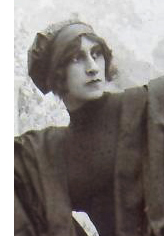 Andriot was unconventionally beautiful, with dark hair and eyes and strong rather than delicate features. She was a genuine athlete, hired initially by Jasset for her riding ability, though he later exploited her acrobatic abilities in chases and scrambles around buildings.
Andriot was unconventionally beautiful, with dark hair and eyes and strong rather than delicate features. She was a genuine athlete, hired initially by Jasset for her riding ability, though he later exploited her acrobatic abilities in chases and scrambles around buildings.
Protéa has now been restored, though there is still missing footage. The heroine’s partner is Lucien Bataille, looking rather like a particularly devious James Cagney in the role of L’Anguille (“The Eel”), whose quick-change abilities and athleticism match hers. The thin, episodic plot revolves around a classic Macguffin, a treaty between two imaginary, vaguely Eastern European countries. The pair must acquire the document and hold onto it through one danger after another, outnumbered and chased all the while by a ruthless gang of spies for the other side.
I was startled by how modern the film seemed. Critics today tend to claim, inaccurately, that big action films throw some big thrill at the audience every few minutes. Protéa really does. The underlying purpose of the plot is to have the two leads escape from one sticky situation and change disguises, only to land immediately in another sticky situation. It’s essentially a serial boiled down into a feature.
The term “cinema of attractions” was originally coined by Tom Gunning to describe very early films that depended on novelties rather than narratives. These days, many academics apply the phrase to almost any film, old or new, boasting a lot of action and big special effects. But I’m tempted to use it of Protéa anyway. Jasset usually doesn’t keep Protéa and L’Anguille in any one disguise or situation long enough to exploit the initial premise. One moment she’s pretending to be a man; next thing we know, she’s an elegant partygoer and L’Anguille is a servant. The basic problem is that whenever the characters get into trouble, they don’t rise to the occasion by exploiting their current roles more cleverly. They just flee and assume a new disguise to try again. As a result most of the individual episodes remain unmemorable.
One exception is a sustained sequence showing the couple as traveling animal trainers. At one point they crawl into the cage and play with a real lion, and they stay in these disguises long enough to actually use the big cats to fend off their pursuers. The final hectic chase, with Protéa on a bicycle fleeing toward a bridge set aflame by the villains, is the most impressive passage we can enjoy as sustained action. (I won’t reveal how it comes out, except to say that the climactic moment prefigures a modern action heroine driving a bus toward a gap in an unfinished freeway.)
Protéa is fun, in large part due to the talent of the two leads. It’s a pity that this was Jasset’s penultimate film. He died in hospital before it was released. (His last film, La Danseuse de Kali, also starring Andriot, was recently rediscovered by our friend Hiroshi Komatsu and was shown in this year’s festival.) Perhaps Jasset would have developed into one of the major directors of serials. Still, one can see why Feuillade, who knew how to build suspense by stretching out a scene’s action, became the French master of the form.
Etaix Refurbished
In an earlier entry, I mentioned that for some years French comic director and actor Pierre Etaix had not controlled the rights to his own films (two shorts and six fiction features). During that time, they were out of circulation and unavailable in any format. That situation has finally been rectified. Etaix has recovered the rights, and all the films have now been restored. They were re-premiered earlier this year at Cannes, and two were included in Il Cinema Ritrovato: the short Heureux anniversaire (1962) and the feature Le grand amour (1969).
Etaix’s early work in the cinema was during the 1950s as an assistant to Jacques Tati, and he is widely seen as having been greatly influenced by Tati. That’s true to some degree. In Le grand amour there are gags using sudden peculiar noises. Although the plot centers around the hero Pierre, his wife Florence, and his in-laws, there are nosy neighbors and waiters through whose eyes we are occasionally asked to view the action. When Pierre’s friend gives him instructions on how to behave on an upcoming date with his pretty secretary, bar patrons assume that they’re witnessing two gay men flirting.
Still, Etaix’s general approach is not particularly Tatian. He does not play a continuing character from film to film. In Le grand amour, as the young husband lured into managing his father-in-law’s factory, he dresses in conservative suits and casual wear; no Hush Puppies, striped socks, and too-short raincoat for him. Pierre succeeds in his dull job, unlike Hulot, who makes a mess of things when given a low-level job at his brother-in-law’s factory. The neighbors watch Pierre not because he is eccentric, but because they jump to wrong conclusions about his mundane behavior.
More importantly, though, Le grand amour creates a great deal of its humor with a technique that Tati would never use. He frequently shows hypothetical alternatives to the scene at hand. What if Pierre’s sophisticated friend were married to Florence? We see a scene played out with the friend in his place. There is a dream in which Pierre’s bed drives like a car along a country road, encountering other bed-cars and finally picking up the new secretary, hitchhiking by the road. When Pierre finally dares to take the secretary out to dinner, he launches into a nervous, boring monologue on business prospects, and we see him as she does, successively older and grayer with each reverse shot. When the gossipy neighbors pass along a story about Pierre, we see the successively exaggerated versions played out one by one, from the reality in which he merely tips his hat to a pretty woman he passes in a park through overt flirting to a passionate encounter behind a bush.
Le grand amour is not as funny as Tati’s films, but that probably results from an explicit melancholy that underlies this tale of disillusionment with marriage and final acceptance of the realities of life-long love. At times it reminded me more of the playful moments in Truffaut, especially in Shoot the Piano Player. Whether or not one wants to place Etaix in the New Wave, his play between reality and fantasy would seem to put him in the category of “ludic modernism” that Malcolm Turvey spoke about in his paper at the recent Society for the Cognitive Study of the Moving Image conference.
The restored print was beautiful, with the kinds of bright and pastel colors and high-key lighting that one seldom sees in the drab films of today. Presumably the new copies will show at other festivals and in art-houses with DVD releases to come.
Cinephiles’ corner
Bologna brings out a bevy of critics, historians, programmers, and unabashed film lovers of all stripes. Herewith, a sampling from DB.
Two critics for the ages: Kent Jones of Physical Evidence and the World Cinema Foundation, alongside Joe McBride, author of books on Ford, Capra, Welles, and Spielberg.
Dick Abel and Virginia Wright Wexman, both distinguished scholars, flank a copy of Dick’s book, French Cinema: The First Wave–presumably kept under glass like the rare specimen it is.
Curatorial cuddling: Haden Guest of the Harvard Film Archive, Adrienne Mancia retired from MoMA (and once a UW Badger).
The Cottafavi Cult invictus: Critics and programmers Barbara Wurm, Olaf Möller, and Christoph Uber, always in the front row.
Camille Blot-Wellens, director of Film Collections at the Cinémathèque Française tells Danish historian Casper Tybjerg of her restoration of Albert Capellani’s Chevalier de Maison-Rouge (1914).
Two walking film encyclopedias sitting down: Kevin Brownlow, pioneer British historian, director, and collector, and Lee Tsiantis of Turner Classic Movies.
David Meeker, master of British cinema and jazz on the screen; Matthew Bernstein, author of Walter Wanger, a study of the Leo Frank lynching, and other studies of film history and culture.
Mariann Lewinsky, heroic programmer of the 1910 series and the Capellani retrospective, introduces Nikolaus Wostry, of Filmarchiv Austria.
More to come in at least one more Bologna-based entry!
Everybody’s Irish
Three Bad Men (1926) at the Piazza Maggiore; Orchestra del Teatro Communale di Bologna conducted by Timothy Brock. Photo by Lorenzo Burlando.
DB, still in Bologna:
The early Ford retrospective at Cinema Ritrovato rolls on. The surviving reel of The Last Outlaw (1919) proved very tantalizing. An end-of-the-West Western, it shows its grizzled hero revisiting the town of his youthful exploits. But now, in an anticipation of Ride the High Country (1962), civilization has taken over. Cars chase Bud off the streets and the theatre features movies (Universal Bluebirds at that, a bit of product placement). Ford heightens the contrast by letting us into the hero’s memory, introduced by the title: “Memories of the past flashing back to him”—the earliest reference to the term “flashback” I recall seeing in the movies.
The plot of Cameo Kirby (1923) involves a cardsharp who tries to help a southern family but whose chivalrous intentions are misunderstood. The film’s virtues were, I’m afraid, undercut by a choppy, contrasty print. Another 1923 vehicle, North of Hudson Bay (1923) was in much better shape. A fairly routine adventure about schemers trying to take over the gold claim of two brothers, it was enlivened by a mysterious murder scene, in which a man is shot before our eyes but we can’t say exactly how. Ford later replays the scene to clarify what happened, and then sets up suspense as the trap is put in play again, this time to kill our hero.
Kentucky Pride (1923) is a turf tale narrated by a racehorse. This might have become a tedious gimmick, but the film handles it with aplomb and modest emotion. Our narrator Virginia’s Future stumbles during the race, and the scene during which she is about to be shot generates a great deal of suspense and concern. At the end, her reunion with her son, Confederacy, is smoothly integrated into the humans’ reconciliations and just deserts. In between, Virginia’s Future passes from owner to owner, in something of a rough draft for the adventures of Bresson’s donkey in Au hazard Balthasar.
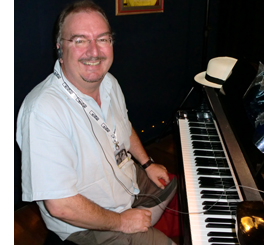 Kentucky Pride is a programmer, but between the peaks of racetrack excitement we get several arresting interludes. In one scene the now-destitute horse farmer reunites with his daughter. He’s at the dinner table. She comes up behind him and covers his eyes. So far, so conventional. But he raises his calloused, dirtied hands very slowly to touch her wrists. Prolonging the gesture shows not only Ford’s delicate way with such moments but the quiet skill of Henry B. Walthall; it’s impossible not to think of similar handwork in Griffith’s The Avenging Conscience (1914) and The Birth of a Nation (1915). The scene’s subdued pathos was enhanced by the accompaniment of Neil Brand, a Bologna regular.
Kentucky Pride is a programmer, but between the peaks of racetrack excitement we get several arresting interludes. In one scene the now-destitute horse farmer reunites with his daughter. He’s at the dinner table. She comes up behind him and covers his eyes. So far, so conventional. But he raises his calloused, dirtied hands very slowly to touch her wrists. Prolonging the gesture shows not only Ford’s delicate way with such moments but the quiet skill of Henry B. Walthall; it’s impossible not to think of similar handwork in Griffith’s The Avenging Conscience (1914) and The Birth of a Nation (1915). The scene’s subdued pathos was enhanced by the accompaniment of Neil Brand, a Bologna regular.
In another horsy tale, The Shamrock Handicap (1926), the financially challenged aristocrat is an Anglo-Irish lord , and to pay his taxes he sells some of his stable to an American racing entrepreneur. His top rider, Neil, goes along, leaving sweetheart Sheila behind. Once in the US, Neil takes a serious spill and acquires a game leg. Soon the aristocrat and his 120 % Irish household are coming to America to stake everything on racing their pride filly in the Handicap. The whole thing is a pleasant tissue of contrivance and coincidence, allowing Ford some chances for sentiment, camera tricks induced by ether, and gags on Irishness. The horse handler discovers that all his old friends and kinfolk in the New World have become cops.
There were opportunities to develop Sheila as more than a pretty face (that belongs to the enchanting Janet Gaynor), but the plot puts the menfolk to the front. The scenes of Neil’s acceptance in the hard-bitten jockey world show America as a place in which ethnic minorities hang together; his best friend is a Jewish rider who keeps a black valet. The characteristic Ford sadness surfaces in a lovers’ reunion. When Neil greets Sheila at dockside, Ford gives us a painful glimpse of wounded masculine pride. Neil stands waiting with his pals. Has he recovered?
As Sheila approaches, Neil swings his crutch abruptly away from her, as if to hide it. But the same gesture sharply reveals to us that he’s now lame.
In their embrace, the crutch falls away. Neil clutches Sheila as if she were not his sweetheart but his mother; he needs consolation, not passion.
The film may be about male pride, but as ever in Ford a man’s sense of self-worth is sustained by a touching reliance on women. So it’s fitting that the walking staff Neil leaves behind in Ireland–a slip in continuity, you might think–becomes his new crutch when he comes home again for good.
Lightnin’ (1925) moves not like lightning but at the pace of its elderly protagonist, Bill (Lightnin’) Jones. The opening is a drawling play with rustic humor, centering on Bill’s laborious stratagems to hide his whisky bottles from his wife. Bill isn’t Irish, but he might as well be, like the purported Welshmen of How Green Was My Valley (1941).
Initially the film seems to depend on one of those promising screenwriting switcheroos. The couple manage a hotel perched on the border between California and Nevada, so aspiring divorcées can collect their California mail and still maintain residency in Nevada. A dividing line runs through the center of the house, and it provides some adroit byplay when a young lawyer, pursued by corrupt businessmen, teases the Nevada sheriff by hopping from state to state. The romance between the lawyer and the old couple’s adopted daughter is handled briskly, with the usual repeated-and-varied dialogue motifs (courtesy Frances Marion’s script). One might expect a climax wringing comic confusion out of the divided household. But soon the border gimmick is forgotten and Ford moves to the emotional core of the movie, the testing of the old couple’s marriage.
When Mrs. Jones tries on a guest’s fashionable dress to find out what it’s like to wear nice clothes, Bill reacts obtusely. It’s his indifference as much as her decision to sell the hotel to land-grabbers that pushes her to sue for divorce. The climax is a prolonged trial scene in which Bill becomes his own advocate. As in later folkish tales like Judge Priest (1934) and The Sun Shines Bright (1953), plot dynamics take a back seat to horseplay and quietly detailed scenes of character reaction and reflection. Some laughs are milked from the family dog wavering between husband and wife, the judge flirting with a flapper, and the dimwitted drinking buddy with his two pudgy children. But soon Bill is fingering his Civil War medal as he slowly confesses his faults as a husband, and we recognize what we’d learn to call a pure Fordian moment.
Those were the days when you could make a film about old people.
For more on Ford, visit Tag Gallagher’s generous and wide-ranging website. It includes a revised version of his critical biography on the Skipper, as well as articles on many other filmmakers. For more Cinema Ritrovato photos, go here. For Gabe Klinger‘s rapid-fire Bologna updates, try Mubi. And for remarks on non-Fordian entries in this abundant festival, check in with us again soon.
John Ford, silent man
John Ford on the set of Air Mail (1932).
DB here:
This is the busiest installment of Cinema Ritrovato I can recall. We scarcely have time to sleep, let alone blog. The coordinators Peter von Bagh, Gian Luca Farinelli, and Guy Borlée have outdone themselves in offering something for everybody, from early films to postwar French and Italian rarities up through a tribute to Stanley Donen and special screenings of The Leopard and Metropolis. Our attention has been riveted by the 1910 programs and an extensive collection of films directed by Alberto Capellani, a little-known master of silent film.
One headliner is the early Ford series: all his surviving silents, plus a selection of rarely-seen talkies. The first one screened, The Black Watch (1929), concentrates on intrigue in the Khyber Pass during World War I. Captain King is assigned to India while the rest of his Scots regiment is sent to Europe. In India, King masterminds the defeat of the forces of Yasmani, a woman who has been taken as sort of a goddess by her followers. The central section, involving Yasmani’s passion for King and his betrayal of her, seems to me sketchy and rushed; Ford’s real interest, not surprisingly, is in the rites of comradeship among the Black Watch. Twenty-two of the film’s 91 minutes are taken up with the opening dinner celebrating the regiment, conducted while King gets his assignment. Since his mission is secret, he abandons his comrades and suffers their opprobrium. A bookended sequence at the close shows him returning to the Watch as, in the trenches of war, they hold another dinner, complete with ruffles and flourishes.
Some of the central portion was directed by Lumsden Hare, but it too has some striking moments, perhaps most memorably the display of Yasmani’s powers when she conjures up an eerie vision of the European battlefield in a glowing crystal ball. The war sequences have the dank Expressionist look that Murnau brought to Fox and that Ford exploited in Four Sons (1928). There are as well touching train-station farewells between brothers and between father and daughter, all of which seem very Fordian. Overall, Ford finds ways to avoid the multiple-camera shooting common to early talkies, often using offscreen dialogue during reaction shots.
Also fairly free of multicamera work was The Brat (1931). Like many talkies derived from a creaky Broadway play, it entices us with a “cinematic” curtain-opener. Cops (including the young Ward Bond) hustle perps into night court, all captured in a flurry of high and low angles, bursts of deep space, and swift tracking shots. Afterwards things slow down, enlivened by some social satire (the pretentious novelist writes with a quill pen), a few sight gags (an artist’s muscled model who discovers he’s been rendered in a faux-Cubist image) and an all-in grappling fight between a society dame and a girl from the other side of the tracks. According to Ford, the fight got its impact from the fact that the actresses couldn’t stand each other.
The first silent Fords were introduced by Joe McBride. “When the real West ended,” Joe remarked, “the cinematic West began.” Born soon after the closing of the frontier, Ford was fascinated by cowboys and Native Americans. Early filmmakers were to a surprising extent celebrating the stoic Indians uprooted and forced to give up their way of life, and this resonated with Ford. The elegiac quality we find in The Man Who Shot Liberty Valance (1962) and other late films, Joe suggested, was already there in the genre. Ford’s own first Westerns, thanks partly to the presence of Harry Carey, carry an air of resignation to history. Even the fragmentary sequences surviving from The Secret Man (1917), in which Harry must sacrifice his freedom to save a little girl, have a severe melancholy.
Hell Bent (1920) has long been famed for its flashy, unrepeatable shot: A carriage pulled by horses tumbles into a ravine; the camera tilts down to follow the crash; and then the horses, freed at the top, come hurtling back into the frame to pass the wreckage. Otherwise the film is consistently agreeable, suffused with Fordian camaraderie among drunks and respect between hero and villain. This last element is starkly dramatized when Harry and his adversary, having wounded each other in a gun duel, must crawl through the desert together.
On my first viewing, I didn’t see in Hell Bent the inventiveness and grace notes I admire so much in Ford’s first feature, Straight Shooting (1917). As we’ve mentioned before, this film shows a mastery of the classical Hollywood style that emerged in the late 1910s. It bears comparison with William S. Hart films of the period, high points of filmmaking craft. Late in the plot Ford give us a shootout with ever-tighter framings that could have come out of Leone.
Whether Ford invented this particular piece of cinematic rhetoric we can’t say; too many silent films are lost. But coming from a 23-year-old filmmaker in his first feature, this remains a remarkably assured use of the continuity editing system for 1917.
Ford’s debt to Griffith has often been noted, and in this movie it turns up in unexpected ways. At one point Joan tenderly puts away the plate her dead brother had used, as if to preserve it. Later, Ford recalls the gesture when the cabin is under siege and bullets blow apart other plates on the sideboard. But Ford has already quietly suggested an association between brother Ted and Cheyenne Harry; as Joan kisses the plate before putting it away, Ford cuts to Harry outside, and then back to Joan slipping the plate into a drawer. Using the then-current technique of a “ruminative cut”, the editing suggests that Joan may also be thinking of Harry, and he of her. The idea of Harry replacing Ted is made explicit at the end when Sims plaintively asks Harry, “You be my son.”
The Griffith influence is particularly acute in Straight Shooting’s climax, when the farmers are under siege in the Sims cabin. Horsemen gallop around the cabin as hired gunmen pepper it with bullets. Meanwhile, Cheyenne Harry has persuaded Black-Eyed Pete’s gang of outlaws to rescue the settlers, and Ford gives us a rousing passage of rapid crosscutting. It’s a canonical last-minute rescue, straight out of the climax of The Birth of a Nation (191t5).
Or more particularly, I think, out of The Battle at Elderbush Gulch (1914). Griffith commonly staged interior scenes with doors at the left and right of the frame, letting actors play laterally. The strategy can be considered somewhat theatrical, in that we never see the “fourth wall” that would in reality enclose the characters.
But this leads to problems when you want to show your characters surrounded. In Elderbush Gulch, the settlers are besieged by encircling Indians. At one point, Griffith cuts from the exterior of the cabin to the interior, and to convey the sense of enclosure he has one of the settlers firing “through” the fourth wall, as if over the heads of the audience!
This is an awkward compromise, but at least give Griffith credit for grasping that his dollhouse playing area doesn’t fully render a realistic space. In Straight Shooting Ford provides a more three-dimensional rendering of interiors. Even though most scene in the Sims cabin lacks Griffith’s side walls, the set yields layers of depth, and the famous door in the back of the set opens on to the porch and the farm outside.
During the gunmen’s siege, we get a strong sense of enclosing space by virtue of the cuts of men firing from different angles. In addition, the cabin interior displays a little more angular depth.
But even Ford can’t escape compromises. We never see the space “behind us” in the Sims’ cabin, and as the farmers take up positions at windows, Ford shows us old Sims readying to fire by turning toward the camera and, like Griffith’s settler, aiming through the fourth wall.
The two shots of Sims in this posture go by fast, and they’re less noticeable because the siege hasn’t quite begun. Still, the anomaly indicates that in this setting Hollywood technique still doesn’t give the sense of a wraparound space that we get in the exterior scenes, like the shootout. A few years after Straight Shooting, American directors would master the ability to build up a four-walled interior through careful cutting. Those techniques would then be exploited for dramatic effect, as in Lubitsch’s Lady Windermere’s Fan (1925).
More to come, but now I must rush off to a morning of early film! If you’re hungry for more in the meantime, visit our category Festivals: Cinema Ritrovato for highlights of earlier years.












